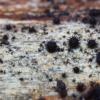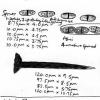
20-12-2025 23:08
Patrice TANCHAUDBonsoir, récolte sur sol sablonneux dans l'arri�

21-12-2025 09:32
Hello.A tiny ascomycete found embedded in wood in

20-12-2025 15:47
Mirek GrycHi.These grew on pine wood that was heavily covere

18-12-2025 21:17
Pol DebaenstThe identification took me to Byssonectria deformi

15-12-2025 07:09
 Danny Newman
Danny Newman
indet. Rutstroemiaceae sp. on unk. fallen leavesMc

19-12-2025 10:10
Patrice TANCHAUDBonjour, récolte réalisée en milieu dunaire, a

18-12-2025 17:23
 Bruno Coué
Bruno Coué
Bonjour,je serais heureux d'avoir votre avis sur c
Hairy Black Spheres on Salix Caprea
Peter Thompson,
28-10-2013 13:54
I recently found some small black spheres with radiating, pointed hairs. They resemble the larger Lasiosphaeris hirsuta macroscopically, but microscopically their characteristics are very different. They have brown, 1-septate spores and asci which contain only 4 spores which develop to maturity.
The combination of macroscopic and microscopic characteristics do not even suggest a genus, let alone a species.
I wonder if anyone has any idea as to what they might be?
A photograph of the fruit bodies and a sketch of the microscopy are attached.
Thank you,
With Best Wishes,
Peter.
Bernard Declercq,
28-10-2013 15:16

Re : Hairy Black Spheres on Salix Caprea
Hello Peter,
I collected exactly the same taxon on a branch of Salix last week. The 0,2-0,25 mm diam. ascomata were in company of some remnants of a corticioid basidiomycete. Most probably a Helminthosphaeria, close to H. odontiae. The latter has however apiosporous spores.
Bernard
I collected exactly the same taxon on a branch of Salix last week. The 0,2-0,25 mm diam. ascomata were in company of some remnants of a corticioid basidiomycete. Most probably a Helminthosphaeria, close to H. odontiae. The latter has however apiosporous spores.
Bernard
Andrew N. Miller,
28-10-2013 15:53

Re : Hairy Black Spheres on Salix Caprea
This is Helminthosphaeria pilifera Réblová (see Réblová 1999).
Réblová M. 1999. Teleomorph-anamorph connections in Ascomycetes 3: Three new lignicolous species of Helminthosphaeria. Sydowia 51: 233–244.
Andy
Réblová M. 1999. Teleomorph-anamorph connections in Ascomycetes 3: Three new lignicolous species of Helminthosphaeria. Sydowia 51: 233–244.
Andy
Peter Thompson,
28-10-2013 16:32
Re : Hairy Black Spheres on Salix Caprea
Hello Andy and Bernard,
Thank you for your quick replies to my query and for identifying my sample.
I have downloaded a copy of the Sydowia paper and will have a read.
With Best Wishes,
Peter.
Thank you for your quick replies to my query and for identifying my sample.
I have downloaded a copy of the Sydowia paper and will have a read.
With Best Wishes,
Peter.
Bernard Declercq,
28-10-2013 19:15

Re : Hairy Black Spheres on Salix Caprea
Hello Andy,
I had excluded to call my collection H. pilifera because spores measure 7,5-10,5x3,5-4,5 µm and ascomata are not collapsed once dry while Réblova (1999) mentions that H. pilifera is characterized by deeply collapsing ascomata by lateral pinching and spores (8,5)9,5-12,5(13,5)x5-5,5(7,5) µm.
Best regards,
Bernard
I had excluded to call my collection H. pilifera because spores measure 7,5-10,5x3,5-4,5 µm and ascomata are not collapsed once dry while Réblova (1999) mentions that H. pilifera is characterized by deeply collapsing ascomata by lateral pinching and spores (8,5)9,5-12,5(13,5)x5-5,5(7,5) µm.
Best regards,
Bernard
Andrew N. Miller,
28-10-2013 19:23

Re : Hairy Black Spheres on Salix Caprea
Spore measurements given are ~9-11 X 4-5µm which fits H. pilifera. I do not know whether or not the ascomata collapse.
H. odontiae has spores with an eccentric septum, not a centric septum as shown.
Best,
Andy
H. odontiae has spores with an eccentric septum, not a centric septum as shown.
Best,
Andy
Gernot Friebes,
28-10-2013 20:56
Re : Hairy Black Spheres on Salix Caprea
Hi Andy,
just out of curiosity - the fact that H. pilifera has been described with 8-spored asci and Peter's find is 4-spored has no impact on the identification? Is it possible for this or other Helminthosphaeria species have both 4- or 8-spored asci?
Thanks and best wishes
Gernot
just out of curiosity - the fact that H. pilifera has been described with 8-spored asci and Peter's find is 4-spored has no impact on the identification? Is it possible for this or other Helminthosphaeria species have both 4- or 8-spored asci?
Thanks and best wishes
Gernot
Andrew N. Miller,
28-10-2013 21:03

Re : Hairy Black Spheres on Salix Caprea
OPPS! I completely missed that obvious character.
Helminthosphaeria heterotricha can be 4-spored, but the spores are 1-celled.
Helminthosphaeria ludens can be 4-spores, but the spores are larger (17–26 × 7–9 µm).
Helminthosphaeria triseptata can be 4-spored, but the spores are also larger (13–17 × 5–6.5 µm).
So, yes, some Helminthosphaeria species can have 4-8 spores. It is variable in some species.
Andy
Helminthosphaeria heterotricha can be 4-spored, but the spores are 1-celled.
Helminthosphaeria ludens can be 4-spores, but the spores are larger (17–26 × 7–9 µm).
Helminthosphaeria triseptata can be 4-spored, but the spores are also larger (13–17 × 5–6.5 µm).
So, yes, some Helminthosphaeria species can have 4-8 spores. It is variable in some species.
Andy
Peter Thompson,
28-10-2013 23:44
Re : Hairy Black Spheres on Salix Caprea
Hello Andrew and Bernard,
I have just looked at the dried sample and there are obvious signs of collapse of the fruit bodies.
With Best Wishes,
Peter.
I have just looked at the dried sample and there are obvious signs of collapse of the fruit bodies.
With Best Wishes,
Peter.
Alex Akulov,
30-03-2018 21:11

Re : Hairy Black Spheres on Salix Caprea
Hello
Today I finded this mysterious Helminthosphaeria too. But my specimen from decorticated Tilia wood. Perithecia 280-310 x 240-260, superficial, black, densely-setose, not collapsing. Setae dark, 80-170 x 5,8-10,5. Asci (4)-6-(rarely also 8)-sporous; av. 55 x 7 (if 6-sporous). Paraphyses numerous, hyaline. Ascospores brown, 1-septate, two-guttulate, (7,4)-8,6-10,1 x (3,4)-3,7-4,4-(4,7).
Similar species H. pilifera has significantly larger ascospores: (8,5) 9,5-12,5 (13,5) x 5-5,5 (-7,5)
Another possible variant - H. odontiae: (6,0-) 8,0-10,7 (-12,7) × (3,0-) 4,0-6,0 (-7,5) µm, 0 (-1-2)-septate
What is it really?
Alex
Today I finded this mysterious Helminthosphaeria too. But my specimen from decorticated Tilia wood. Perithecia 280-310 x 240-260, superficial, black, densely-setose, not collapsing. Setae dark, 80-170 x 5,8-10,5. Asci (4)-6-(rarely also 8)-sporous; av. 55 x 7 (if 6-sporous). Paraphyses numerous, hyaline. Ascospores brown, 1-septate, two-guttulate, (7,4)-8,6-10,1 x (3,4)-3,7-4,4-(4,7).
Similar species H. pilifera has significantly larger ascospores: (8,5) 9,5-12,5 (13,5) x 5-5,5 (-7,5)
Another possible variant - H. odontiae: (6,0-) 8,0-10,7 (-12,7) × (3,0-) 4,0-6,0 (-7,5) µm, 0 (-1-2)-septate
What is it really?
Alex
Andrew N. Miller,
30-03-2018 21:20

Re : Hairy Black Spheres on Salix Caprea
If you send me the material (with 20-30 ascomata), I would be happy to sequence it. Let's see what the DNA says... ;o)
Cheers,
Andy
Cheers,
Andy


